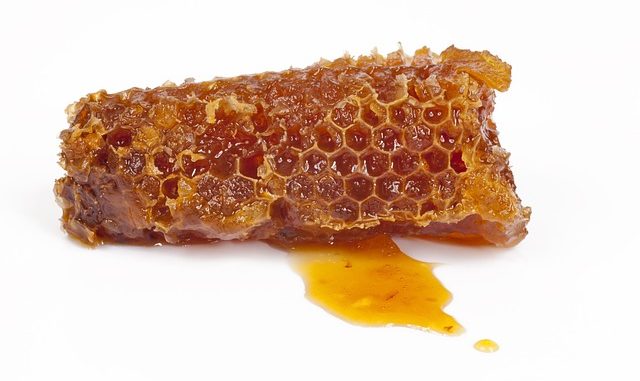
Propolis is a natural resinous substance collected by bees from parts of plants, their buds, and other exudates as they pollinate them (Ghisalberti 1979). This resin is eaten then chewed and masticated by adding enzymes from their saliva. The partially digested resin is mixed with beeswax for use as a glue in the hive where it makes for an effective building material. Using propolis dates as far back as 300 B.C. according to ancient papyrus.
As well as producing this material, bees are renowned the world over for producing honey too. In both cases the quality of both products from bees depends heavily on where they live and are kept and the type of plants and flowers they visit.
Compounds
Propolis contains many unusual compounds which are naturally present in the source plants from which they are derived. We usually find flavonoids, phenolic acids and various esters (Bankskota et al., 2001), phenolic aldehydes, alcohols and ketones, quinones, steroids, and amino acids (Chaillou and Nazareno, 2009). There is also special interest in the various diterpenes because of their significant health and antifungal/antibacterial properties.
Various sugars and their derivatives are known. The main flavonoids are rutin (quercetin 3‐O‐rutinoside) (Bonhevi and Call, 1994) and isorhamnetin‐3‐O‐rutinoside (Popova et al., 2009).
Geographical Differences In Composition
The chemical profiles of components in all samples will vary considerably from where they are collected. A product from Malta or the Mediterranean in general will have a distinctively different composition from one sourced from Asia or Africa. These regional differences are important both in terms of cost but also efficacy and their various uses which are highlighted below.
Uses
A regular component of folk medicine (Ghisalberti 1979; Marcucci 1995). It is a natural medicine and has many reputed benefits which include being:
- antibacterial,
- antifungal,
- antitumor,
- antioxidative,
- anti-inflammatory,
- immunomodulatory,
- antihepatotoxic (liver protecting),
- various other beneficial activities.
In the food sense, propolis is is taken as a health drink in all sorts of countries from Asia, to Europe and the Americas.
The resin is also a component of various cosmetics.
Inhibitory Benefits Of Propolis Extracts
The inhibition of many bacteria especially food poisoning types appears to be a possible source of interest that could be made more use of in the packaging industry. Chitosan has long been touted as a useful active food packaging material especially when it is made a composite with other compounds including propolis extract (PE). There is just one study (Siripatraw & Vitchayaki, 2016) which looked at a combination of the two materials. The level of PE to chitosan added was increased from 2.5% to 20%. There was inhibitory activity against Staphylococcus aureus, Salmonella enteritidis, Escherichia coli, and Pseudomonas aeruginosa. The effects are due in part to a combination of both materials rather than just one enhancing the efficacy of the other. One issue appears to be the development of an increasingly yellow packaging material as more PE is added.
References
, , . (2001) Recent progress in pharmacological research of propolis. Phytother. Res. 15 pp. 561–71 (Article).
, . (1994) Phenolic composition of propolis from China and from South America. Z Naturforsch C. 49 pp. 712–18 (Article).
(1979) Propolis: a review. Bee World 60 pp. 59–84 (Article).
(1995) Propolis: chemical composition, biological properties and therapeutic activity. Apidologie 26 pp. 83–99 (Article).
, , ,. (2009) Terpenes with antimicrobial activity from Cretan propolis. Phytochemistry 70 pp. 1262–71
Siripatrawan, U., & Vitchayakitti, W. (2016). Improving functional properties of chitosan films as active food packaging by incorporating with propolis. Food Hydrocolloids, 61, pp. 695-702 (Article).
Leave a Reply